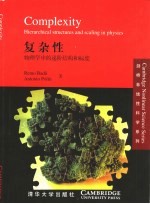
- 作 者:(美)Remo.Badii,Anotoino.Politi著
- 出 版 社:北京:清华大学出版社
- 出版年份:2000
- ISBN:7302039038
- 标注页数:318 页
- PDF页数:328 页
请阅读订购服务说明与试读!
订购服务说明
1、本站所有的书默认都是PDF格式,该格式图书只能阅读和打印,不能再次编辑。
2、除分上下册或者多册的情况下,一般PDF页数一定要大于标注页数才建议下单购买。【本资源328 ≥318页】
图书下载及付费说明
1、所有的电子图书为PDF格式,支持电脑、手机、平板等各类电子设备阅读;可以任意拷贝文件到不同的阅读设备里进行阅读。
2、电子图书在提交订单后一般半小时内处理完成,最晚48小时内处理完成。(非工作日购买会延迟)
3、所有的电子图书都是原书直接扫描方式制作而成。
Part 1 Phenomenology and models 1
Chapter 1 Introduction 3
1.1 Statement of the problem 3
1.2 Historical perspective 7
1.3 Self-generated complexity 9
Chapter 2 Examples of complex behaviour 12
2.1 Instabilities in fluids 13
2.1.1 Temporally"complex"dynamics 13
2.1.2 Spatio-temporal"complexity" 15
2.2 Turbulence 17
2.3 Biological and chemical reactions 19
2.4 Optical instabilities 21
2.5 Growth phenomena 23
2.6 DNA 26
2.6.1 The genetic code 27
2.6.2 Structure and function 29
Chapter 3 Mathematical models 32
3.1 Reduction methods for partial differential equations 33
3.2 Ordinary differential equations 37
3.3 Mappings 39
3.3.1 Strange attractors 41
3.4 Cellular automata 48
3.4.1 Regular rules 51
3.4.2 Chaotic rules 53
3.4.3 "Complex"rules 53
3.5 Statistical mechanical systems 57
3.5.1 Spin glasses 60
3.5.2 Optimization and artificial neural networks 64
Part 2 Mathematical tools 67
Chapter 4 Symbolic representations of physical systems 69
4.1 Encoding in nonlinear dynamics 70
4.2 Shifts and invariant sets 76
4.2.1 Shift dynamical systems 77
4.3 Languages 78
4.3.1 Topological entropy 81
4.3.2 Substitutions 82
Chapter 5 Probability,ergodic theory,and information 85
5.1 Measure-preserving transformations 86
5.2 Stochastic processes 89
5.3 Time-evolution operators 93
5.4 Correlation functions 96
5.5 Ergodic theory 100
5.5.1 Spectral theory and isomorphism 104
5.5.2 Shift dynamical systems 105
5.5.3 What is the"generic"behaviour? 107
5.5.4 Approximation theories 108
5.6 Information,entropy,and dimension 109
Chapter 6 Thermodynamic formalism 119
6.1 Interactions 119
6.2 Statistical ensembles 123
6.2.1 Generalized entropies 123
6.2.2 Generalized dimensions 128
6.3 Phase transitions 132
6.3.1 Critical exponents,universality,and renormalization 134
6.3.2 Disordered systems 141
6.4 Applications 148
6.4.1 Power spectral measures and decay of correlation functions 148
6.4.2 Thermodynamics of shift dynamical systems 151
Part 3 Formal characterization of complexity 163
Chapter 7 Physical and computational analysis of symbolic signals 165
7.1 Formal languages,grammars,and automata 166
7.1.1 Regular languages 167
7.1.2 Context-free languages 170
7.1.3 Context-sensitive languages 175
7.1.4 Unrestricted languages 177
7.1.5 Other languages 183
7.2 Physical characterization of formal languages 184
7.2.1 Regular languages 184
7.2.2 Context-free languages 187
7.2.3 DOL languages 190
7.2.4 Context-sensitive and recursively enumerable languages 197
7.3 Computational characterization of physical systems and mathematical models 198
7.3.1 Dynamics at the borderline with chaos 198
7.3.2 Quasicrystals 200
7.3.3 Chaotic maps 202
7.3.4 Cellular automata 203
7.3.5 Relationship between Turing machines and dynamical systems 207
7.3.6 Nucleotide sequences 209
7.3.7 Discussion 211
Chapter 8 Algorithmic and grammatical complexities 213
8.1 Coding and data compression 214
8.2 Model inference 219
8.3 Algorithmic information 226
8.3.1 P-NP problems 230
8.4 Lempel-Ziv complexity 233
8.5 Logical depth 235
8.6 Sophistication 237
8.7 Regular-language and set complexities 240
8.8 Grammatical complexity 243
Chapter 9 Hierarchical scaling complexities 248
9.1 Diversity of trees 249
9.1.1 Horton-Strahler indices 252
9.2 Effective-measure and forecasting complexity 253
9.3 Topological exponents 255
9.4 Convergence of model predictions 260
9.4.1 Global prediction 260
9.4.2 Detailed prediction 262
9.5 Scaling function 270
Chapter 10 Summary and perspectives 277
Appendix 1 The Lorenz model 281
Appendix 2 The horseshoe map 283
Appendix 3 Mathematical definitions 285
Appendix 4 Lyapunov exponents,entropy,and dimension 287
Appendix 5 Forbidden words in regular languages 290
References 293
Index 311
